Labour Force
- Home
- Statistics
- Labour Market
- Labour Market Information
- Labour Force
Key Statistics of Labour Force in Malaysia, February 2021
Key Statistics of Labour Force in Malaysia, January 2021 8 February 2021
Key Statistics of Labour Force in Malaysia, December 2020 8 February 2021
Principal Statistics of Labour Force, Malaysia, Fourth Quarter (Q4) 2020 11 January 2021
Key Statistics of Labour Force in Malaysia, November 2020 11 December 2020
Key Statistics of Labour Force in Malaysia, October 2020 9 November 2020
Key Statistics of Labour Force in Malaysia, September 2020 Show all release archives
Overview
-01.png)

KEY REVIEWS
- February 2021 saw the number of employed persons rose by 0.2 per cent or equivalent to 33.3 thousand persons to 15.27 million persons (January 2021: 15.24 million persons). The employment-to-population ratio which indicates the ability of an economy to create employment remained stagnant at 65.2 per cent in February 2021.
- By economic sector, the number of employed persons in Services sector remained on an upward trend month-on-month mainly in Wholesale & retail trade; Education and Human health & social work activities. The employed persons in the Manufacturing and Construction sectors continued to record a positive growth while Agriculture and Mining & Quarrying sectors recorded reductions in the number of employed persons
- The employee’s category which made up the largest composition of employed persons at 77.7 per cent rose by 0.2 per cent (+24.0 thousand persons) to 11.87 million persons (January 2021: 11.85 million persons). Similarly with own-account workers which comprised of 15.9 per cent, augmented to 2.43 million persons in February 2021 (January 2021: 2.39 million persons)
- The unemployment rate dropped 0.1 percentage point to 4.8 per cent in February 2021 as opposed to January 2021. The number of unemployed persons declined by 5.0 thousand persons or 0.6 per cent to record 777.5 thousand persons (January 2021: 782.5 thousand persons).
- During the month, the number of labour force increased by 0.2 per cent or 28.4 thousand persons to 16.05 million persons (January 2021: 16.02 million persons). The labour force participation rate (LFPR) for the month was unchanged at 68.5 per cent.
- Outside labour force in February 2021 registered an additional of 5.2 thousand persons to 7.37 million persons as against the previous month. The largest share of outside labour force was due to housework/ family responsibility with a share of 44.5 per cent or 3.28 million persons and followed by schooling/ training with 42.0 per cent or 3.09 million persons.
- In spite of extensions of the MCO and continued inter-state travel restriction, things are gradually improving since early March 2021 whereby six states have entered the Recovery MCO (RMCO) phase while, another four states have moved into Conditional MCO (CMCO). The pre-primary and primary education sectors began to reopen in stages benefitting school related activities particularly school bus services, school canteens as well as stationery and book shops. Overall, with the continuous economic recovery path and the subsequent positive impact to labour market improvement, it is foreseen that the labour demand may continue to expand marginally and the labour supply will remain competitive.
MARGINAL IMPROVEMENT IN FEBRUARY'S LABOUR FORCE IN PARALLEL WITH THE ENCOURAGING SIGNS OF THE ECONOMY
The Malaysia’s near-term economic prospects are foreseen to be optimistic in line with the deployment of COVID-19 vaccination programme. The latest release of Leading Index for January 2021 posted year-on-year increase of 8.2 per cent. Thus, the labour market continued to experience recovery with the encouraging signs of the economy.
Although the Movement Control Order (MCO) had been extended to 18 February 2021 in all states except for Sarawak, three additional businesses were allowed to operate namely night market, hair salon and car wash with strict standard operating procedures (SOP). On 10 February 2021, the remaining retail sectors were permitted to resume operations which include clothing, fashion & accessory, and shoe stores as well as photography equipment and services to ensure economic sustainability especially among small businesses. Later, more sports and fitness activities were allowed including gym activities, golf, motorsports, tennis and badminton. In addition, the first phase of vaccination programme which started on 24 February 2021 provided some relief to the businesses and community. February 2021 also witnessed the Chinese New Year was celebrated modestly with adherence to SOP where only 15 immediate family members living within the same districts were allowed to gather for the traditional reunion dinner.
Observing the labour force situation in February 2021, it improved marginally as against the previous month with a number of employed persons continued to increase while the number of unemployed persons declined after recording four consecutive months of increases since October 2020. The rise in employed persons during the period was seen largely in Human health and social work and Wholesale and retail trade activities. Comparing year-on -year, the increase in the labour force was attributed by the rise of unemployed persons while the number of employed persons remained on a declining trend.
Additionally, the short-term economic indicators in February 2021 showed that exports and imports registered a decrease of 2.3 per cent and 4.5 per cent respectively. On the contrary, trade surplus increased by 7.6 per cent as compared to the previous month.
The Labour Force Report for February 2021 describes the labour supply situation as the country entered the twelfth month of various phases MCO. The report will elaborate on the month-on-month changes to examine the immediate effects of the MCO to contain the spread of COVID-19. Users are advised to interpret the monthly statistics with caution since they are non-seasonally adjusted. In addition, annual changes from the same month of the previous year are also reported.
Employed persons rose by 0.2 per cent to 15.27 million persons
February 2021 saw the number of employed persons rose by 0.2 per cent or equivalent to 33.3 thousand persons to 15.27 million persons (January 2021: 15.24 million persons). Meanwhile, year-on-year, the number of employed persons continued to decrease since April 2020 posting a decline of 0.5 per cent or equivalent to 73.9 thousand persons (February 2020: 15.34 million persons).
By economic sector, the number of employed persons in the Services sector remained on an upward trend month-on-month mainly in Wholesale & retail trade; Education and Human health & social work activities. Meanwhile, the employment in tourism related industries persisted on a declining trend as a consequence of COVID-19 containment measures. Employed persons in the Manufacturing and Construction sectors continued to register a positive growth while Agriculture and Mining & Quarrying sectors recorded reductions in the number of employed persons.
The employment-to-population ratio which indicates the ability of an economy to create employment remained stagnant at 65.2 per cent in February 2021. However, year-on-year basis, the ratio lessened by 1.2 percentage points as against 66.4 per cent (February 2020). [Chart 1]
Chart 1: Employed persons and employment-to-population ratio, January 2018 - February 2021
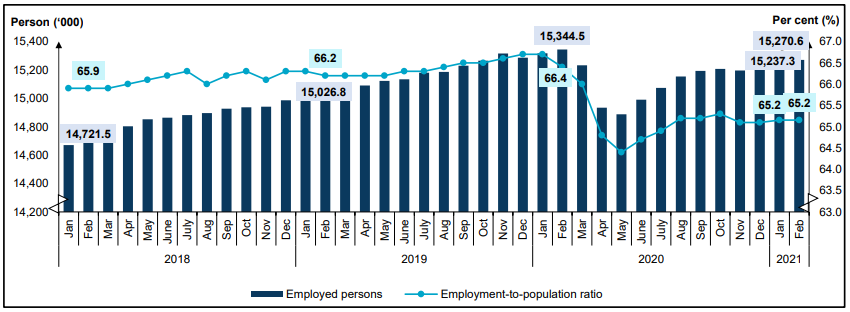
The employee’s category which made up the largest composition of employed persons at 77.7 per cent rose by 0.2 per cent (+24.0 thousand persons) to 11.87 million persons (January 2021: 11.85 million persons). Similar with own-account workers which comprised of 15.9 per cent, augmented to 2.43 million persons in February 2021 (January 2021: 2.39 million persons).
This group comprised mostly of daily income earners working as small business operators such as small retailers; hawkers; sellers in markets and stalls as well as smallholders. The increase in own-account workers could partly be due to the initiatives provided by the government to help the micro as well as small and medium enterprises (SMEs) namely the PRIHATIN Special Grant 2.0 (GKP 2.0). As of 5 February 2021, a total of RM155 million has been credited to about 52,000 SMEs4. [Chart 2]
Chart 2: Employed person by status in employment, January 2021 and February 2021
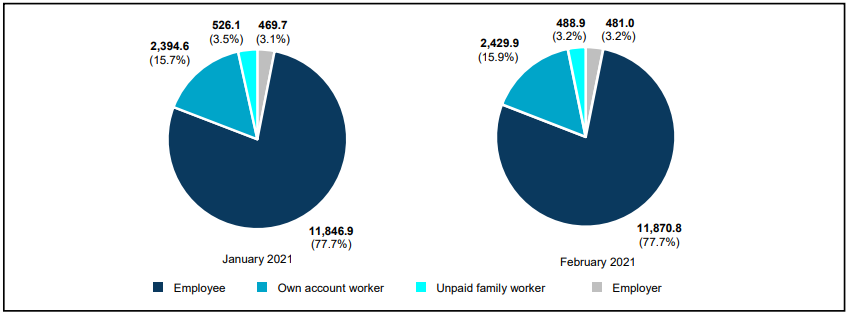
As compared to the previous month, the number of employed persons who were temporarily not working in February 2021 reduced to 150.8 thousand persons (January 2021: 158.9 thousand persons). During the month, most of the business activities were permitted to resume operation including night markets, florists and nurseries, handicraft shops, antique stores, carpet stores, sports equipment shops, cosmetic stores and vehicle accessories store. Furthermore, starting on 18 February 2021, all restaurants were allowed to accept dine-in customers with more than two persons per table5.
In the meantime, year-on-year, the number of employed persons who were temporarily not working increased by 81.2 thousand persons (116.6%) as compared to 69.6 thousand persons in February 2021. This group of persons, who were most likely not able to work was not categorised as unemployed as they had work to return to.
Unemployment rate dropped to 4.8 per cent in February 2021
The unemployment rate dropped 0.1 percentage point to 4.8 per cent in February 2021 as opposed to January 2021. The number of unemployed persons declined by 0.6 per cent or 5.0 thousand persons to record 777.5 thousand persons (January 2021: 782.5 thousand persons).
Meanwhile, in comparison with the same month of the preceding year, the unemployment rate for February 2021 went up by 1.5 percentage points from 3.3 per cent in February 2020. The number of unemployed persons registered an increase of 252.3 thousand persons (February 2020: 525.2 thousand persons). [Chart 3]
Chart 3: Unemployed persons and unemployment rate, 1982 - 2019 and January 2020 - February 2021

During the month, the actively unemployed persons which is defined as those who were available for work and were actively seeking job, reduced by 9.8 thousand persons (1.5%) to 647.4 thousand persons (January 2021: 657.2 thousand persons). Those who were unemployed for less than three months accounted for 50.6 per cent of the actively unemployed. Meanwhile, 11.3 per cent of actively unemployed were in long-term unemployment6 of more than a year. [Chart 4]
In February 2021, the number of inactively unemployed who believed that there were no jobs available rose by 3.8 per cent to 130.1 thousand persons (January 2021: 125.3 thousand persons).
Chart 4: Unemployed category and duration of unemployment, January 2021 and February 2021

The unemployment rate for youth aged 15 to 24 years, increased by 0.4 percentage points to 13.9 per cent in February 2021. The number of unemployed youths increased by 52.4 thousand persons to 347.6 thousand persons as against the previous month (January 2021: 295.3 thousand persons). In the meantime, the unemployment rate for youth aged 15 to 30 years remained at 9.2 per cent. [Chart 5]
Chart 5: Unemployment rate by selected age groups, 1982 - 2019 and January 2020 - February 2021
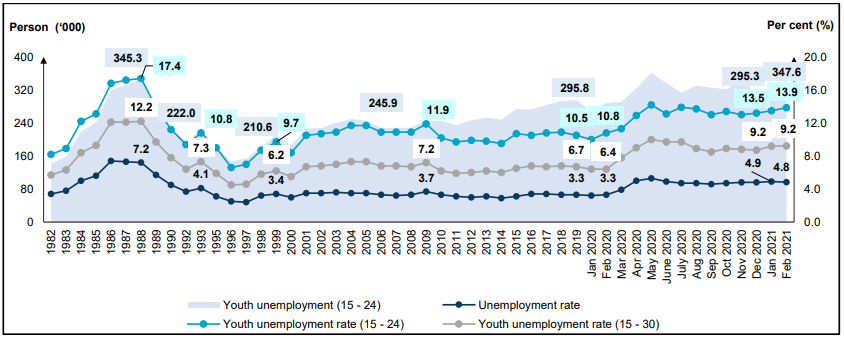
LFPR was unchanged at 68.5 per cent
During the month, the number of labour force increased by 0.2 per cent or 28.4 thousand persons to 16.05 million persons (January 2021: 16.02 million persons). The labour force participation rate (LFPR) for the month was unchanged at 68.5 per cent.
Year-on-year comparison, the number of labour force went up by 178.4 thousand persons (February 2020: 15.87 million persons) while the LFPR decreased by 0.2 percentage points (February 2020: 68.7%). [Chart 6]
Chart 6: Labour force and LFPR, 1982 – 2019 and January 2020 - February 2021

Male LFPR rose 0.1 percentage point to 81.0 per cent while female LFPR edged down by 0.1 percentage point to 55.1 per cent. Male labour force increased by 0.3 per cent or 25.7 thousand persons to 9.82 million persons (January 2021: 9.80 million persons). In the meantime, female labour force rose by 2.7 thousand persons from January 2021 to 6.23 million persons. Year-on-year basis, male LFPR registered an increase of 0.2 percentage points while female LFPR fell by 0.6 percentage points. [Chart 7]
Chart 7: Labour force and LFPR by sex, 1982 - 2019 and January 2020 - February 2021
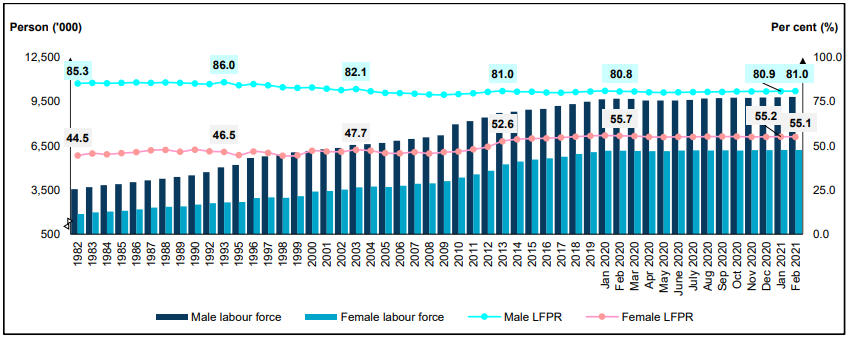
The largest share of outside labour force was due to housework/ family responsibility
Outside labour force in February 2021 registered an additional of 5.2 thousand persons to 7.37 million persons as against the previous month. Similarly, outside labour force went up by 2.0 per cent (+147.3 thousand persons) year-on-year. The largest share of outside labour force was due to housework/ family responsibility with a share of 44.5 per cent or 3.28 million persons and followed by schooling/ training with 42.0 per cent or 3.09 million persons. [Chart 8]
Chart 8: Share of outside labour force by reasons for not seeking work, January and February 2021
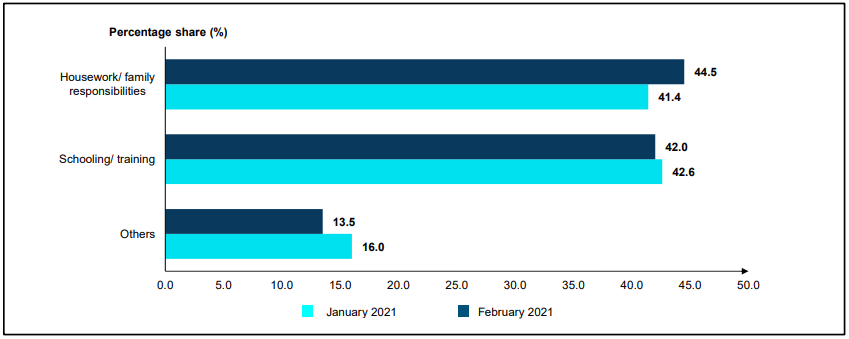
GOVERNMENT’S INITIATIVES
The Wage Subsidy Programme (PSU) 1.0, had benefited a total of 322,177 employers and 2.64 million registered employees as of the closing date for registration of this programme on 30 September 2020. As of 26 February 2021, a total of RM12.77 billion was distributed through this programme. In the meantime, for the Wage Subsidy Programme (PSU) 2.0, a total of RM808.31 million had been distributed to 66,591 employers to assist them in safeguarding their operation and sustaining jobs for 554,876 employees. Additionally, there were 131,568 employees who secured employment through the Recruitment Incentive Programme and Training Assistance with Manufacturing and Wholesales & retails trade were the major industries in hiring workers. Besides, there were 7,536 apprentices and 494 Persons with Disabilities (PWD) successfully secured jobs through this programme. Moreover, a total of 136,927 individuals had been approved to participate in Reskilling and Upskilling Programme offered by various ministries and agencies with the intent to enhance capacity and capability for employability.
As for the PENJANA SME Financing, a total of 6,973 SME applications had been approved with a total loan value of RM1.32 billion to empower the SMEs’ businesses. Under the PENJANA Tourism Financing there were 579 applications with 282 approved financing applications amounting to RM57.1 million. In addition, through the PENJANA Micro Credit Financing under Bank Simpanan Nasional (BSN), 11,708 Micro SMEs had benefited with a total distribution value of RM391.9 million. In the meantime, to assist Bumiputera SMEs who were affected by the pandemic, a total of RM182.8 million through the Bumiputera Relief Financing (BRF) was disseminated to 671 SMEs.
Furthermore, to continue supporting the businesses through the SMEs Soft Loans funds, there were 24,628 SMEs assisted involving RM11.63 billion. This value comprised of Special Relief Facility (SRF), Automation & Digitalisation Facility (ADF), All-Economic Sector Facility (AES) and Agrofood Facility (AF) funds. Moreover, to support the Agriculture and Food Industry, under the Agrobank Micro Credit Financing, a total of RM85.1 million had been channelled to 7,723 Agricultural Micro SMEs. Furthermore, to support the SMEs and Mid-Tier Companies (MTCs), 8,584 businesses were benefited through the grants and loans for subscription to digitalisation services involving RM38.7 million under the Technical and Digital Utilisation support initiative.
Therefore, with a continuous and various supports through the government’s initiatives, the labour market may sustain its recovery momentum and subsequently may lead the labour market to be on a right track towards a sustainable path.
LOOKING AHEAD
In spite of extension of the MCO and continued inter-state travel restriction, things are gradually improving since early March 2021 whereby six states have entered the Recovery MCO (RMCO) phase namely Melaka, Pahang, Terengganu, Sabah, W.P. Putrajaya and W.P. Labuan. Meanwhile, another four states have moved into Conditional MCO (CMCO) which were Selangor, W.P. Kuala Lumpur, Johor and Pulau Pinang. The pre-primary and primary education sectors began to reopen in stages benefitting school related activities particularly school bus services, school canteens as well as stationery and book shops.
This situation coupled with the resumption of more economic activities since February 2021 might encourage more demand in economy and consequently would contribute to a positive impact in the labour market. In line with this, there will be more job opportunities as more labour would be needed to support the business operations.
In addition, starting on 10 March 2021 the domestic tourism activities were allowed within the green zone states albeit with certain restrictions imposed. The travelling activities between RMCO states must hire a registered tour agency and need to obtain an approval from the police prior to travel. These efforts were aimed to help the domestic tourism related activities to recover.
On 17 March 2021, the government launched a new stimulus package namely Strategic Programme to Empower the People and Economy (PEMERKASA). The RM20.0 billion initiative is focused to restore and empower the economy based on five focus areas encompassing to control the spread of COVID 19; to accelerate economic recovery; to strengthen the country’s competitiveness; to implement the regional and community inclusion agenda; and to transform the economy. Among the initiatives that could assist labour market recovery are a RM1,000 PRIHATIN Special Grant 3.0 to the micro and SME businesses and RM700 millions of Wage Subsidy 3.0 targeted towards 400,000 employees and 37,000 employers. In addition, the PEMERKASA package also emphasised on rejuvenating the domestic tourism by extending the exemption for tourism tax and services tax for hotel accommodation. To support cash flow, companies in the tourism related industries also were allowed to delay their payment for monthly income tax for the period of April until December 2021.
Overall, with the continuous economic recovery path and the subsequent positive impact to labour market improvement, it is foreseen that the labour demand may continue to expand marginally and the labour supply will remain competitive.
TECHNICAL NOTES
This information is derived from the Labour Force Survey (LFS) which was conducted to collect information on the structure and distribution of labour force, employment and unemployment.
The survey population cover persons who live in private living quarters and excludes persons residing in institutions such as hotels, hostels, hospitals, prisons, boarding houses and workers residing in construction work site.
The survey comprises of the economically active and inactive population. To measure the economically active population, the LFS uses the age limit of 15 to 64 years. The economically active population comprises of those employed and unemployed whereas those who are inactive is classified as outside the labour force.
LFS uses the actual status approach, where a person is classified on the basis of his labour force activity during the reference week.
- Labour force refers to those who, during the reference week are in the 15 to 64 years (in completed years at last birthday) and who are either employed or unemployed.
- Employed refers to all persons who, at any time during the reference week worked at least one hour for pay, profit or family gain (as an employer, employee, own-account worker or unpaid family worker). Also considered as employed are persons who did not work during the reference week because of illness, injury, bad weather, leave, labour dispute and social or religious reasons but had a job, farm, enterprise or other family enterprise to return to. Also included are those on temporary lay-off with pay who would definitely be called back to work.
- Unemployed
Unemployed refers to those who do not have a job but are interested to work. There are two groups of unemployed that is the actively unemployed and inactively unemployed.
- Outside Labour Force
All persons not classified as employed or unemployed as stated above are classified as outside labour force. Includes housewives, students (including those going for further studies), retired, disabled persons and those not interested in looking for a job.
- Labour Force Participation Rate
The economic activity of a population depends on the demographic characteristics of that population. The proportion of economically active population, therefore, differs between sub-groups of that population. These variations are measured by specific activity rates termed as labour force participation rate. Labour force participation rate is defined as the ratio of the labour force to the working age population (15 to 64 years), expressed as percentage.
- Unemployment rate is the proportion of unemployed population to the total population in labour force. This rate measures the percentage of unemployed population in the labour force.
Population Benchmarks
Population by characteristics of age group, ethnicity and state were used as benchmarks to produce labour statistics.
Starting with the monthly release of the Principal Statistics of Labour Force, Malaysia, January 2016, the principal statistics of labour is estimated based on the current population estimates as compared to the previous series which used population projections based on the Population and Housing Census of Malaysia, 2010. This rebase is to obtain statistics that is more consistent with current population structure.
The full publication of the Labour Force Report, February 2021 can be downloaded through eStatistik Portal. Free Download
For more details, please refer to the Department’s portal: www.dosm.gov.my
Released By:
DATO' SRI DR. MOHD UZIR MAHIDIN
CHIEF STATISTICIAN MALAYSIA
DEPARTMENT OF STATISTICS, MALAYSIA


8 April 2021
Contact person:
Mohd Yusrizal bin Ab. Razak
Public Relation Officer
Strategic Communication and International Division
Department of Statistics, Malaysia
Tel : +603-8885 7942
Fax : +603-8888 9248
Email : yusrizal.razak@dosm.gov.my
Subscribe
Newsletter
Subscribe to our newsletter and stay updated
For interviews, press statement and clarification to the media, contact:
Baharudin Mohamad
Public Relation Officer
Email: baharudin[at]dosm.gov.my
Phone: 03 8090 4681
Not found what you looking for? Request data from us, through
Go to eStatistik
Email: data[at]dosm.gov.my
Phone: 03 8885 7128 (data request)










